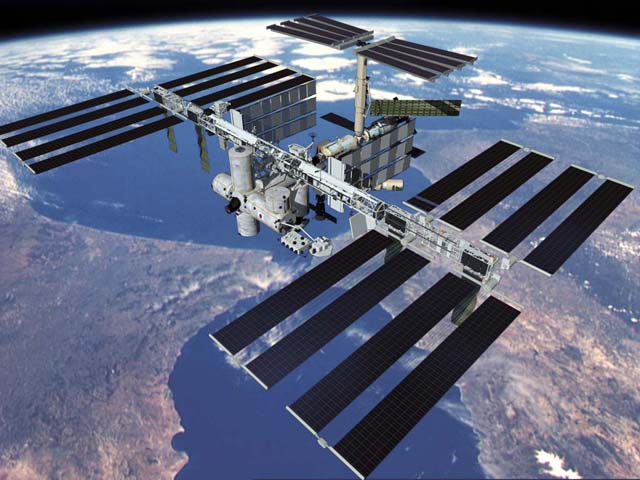The International Space Station (ISS) will allow humanity to send much larger payloads into space and act as a launching platform for vehicles to Mars and other extraterrestrial bodies. Prior to the existence of the ISS we had been forced to limit the size and weight of everything we sent into space because we had to send it all in one piece. Now we can send everything in smaller pieces and have them dock with the ISS, at which point they can be put together. This means that rather than design a more powerful rocket to send out deep space missions we can assemble spacecraft in orbit.
Once the craft has been put together it can launch from the space station using much less force than would be necessary from Earth's surface. This is because the ISS is in Low Earth Orbit (LEO) and already moving at around 8 km/s, thus the change in speed needed to reach Earth's escape velocity is much less. Escape velocity from Earth's surface is about 11.2 km/s, which means that a ship must accelerate to that velocity from a motionless state. Escape velocity from LEO is a little less than from the surface at about 10.9 km/s, but since the ISS is already moving at around 8 km/s a craft launching from it will only have to accelerate 2.9 km/s to reach escape velocity.
It is impractical for a spacecraft leaving from the surface to attempt to reach escape velocity because moving at that speed in the atmosphere would cause it to burn up due to friction or be destroyed by atmospheric pressure. While there are ways around these problems, they only add unnecessary cost and bulk to the spacecraft. Because the atmosphere is much thinner in LEO objects can attain escape velocity without encountering as much friction. Launching from the ISS will allow a spacecraft to escape Earth's gravity without as much wear on the craft itself.
With less acceleration needed and wear sustained, much larger ships could be pieced together, fueled, and launched from the ISS, thus eliminating the need to develop even more massive rocket boosters to launch from the surface into deep space.
A rocket could be launched from the surface to the ISS carrying part of the spacecraft inside it. The spacecraft itself would not experience any wear and could be offloaded at the Station. Once the pieces are put together and the spacecraft fueled, it could then propel itself, accelerating the additional 2.9 km/s and escape Earth's gravity. Once it does this the craft would be able to use momentum to take it where it needs to go. A reserve fuel supply could enable any needed course corrections and thrusters for landing on Mars or other terrestrial bodies. A separate unmanned ship full of fuel could have left prior to the manned mission and be waiting on the surface. It may even be possible to generate fuel from the environment of the extraterrestrial planet by converting it to Hydrogen gas, or other usable material. But that's a different topic entirely.
Whether we send humans to Mars and beyond or just more robots, the International Space Station will be instrumental in allowing us to deliver larger payloads further into space.
 |
| The International Space Station Source: NOVA |
Once the craft has been put together it can launch from the space station using much less force than would be necessary from Earth's surface. This is because the ISS is in Low Earth Orbit (LEO) and already moving at around 8 km/s, thus the change in speed needed to reach Earth's escape velocity is much less. Escape velocity from Earth's surface is about 11.2 km/s, which means that a ship must accelerate to that velocity from a motionless state. Escape velocity from LEO is a little less than from the surface at about 10.9 km/s, but since the ISS is already moving at around 8 km/s a craft launching from it will only have to accelerate 2.9 km/s to reach escape velocity.
It is impractical for a spacecraft leaving from the surface to attempt to reach escape velocity because moving at that speed in the atmosphere would cause it to burn up due to friction or be destroyed by atmospheric pressure. While there are ways around these problems, they only add unnecessary cost and bulk to the spacecraft. Because the atmosphere is much thinner in LEO objects can attain escape velocity without encountering as much friction. Launching from the ISS will allow a spacecraft to escape Earth's gravity without as much wear on the craft itself.
With less acceleration needed and wear sustained, much larger ships could be pieced together, fueled, and launched from the ISS, thus eliminating the need to develop even more massive rocket boosters to launch from the surface into deep space.
A rocket could be launched from the surface to the ISS carrying part of the spacecraft inside it. The spacecraft itself would not experience any wear and could be offloaded at the Station. Once the pieces are put together and the spacecraft fueled, it could then propel itself, accelerating the additional 2.9 km/s and escape Earth's gravity. Once it does this the craft would be able to use momentum to take it where it needs to go. A reserve fuel supply could enable any needed course corrections and thrusters for landing on Mars or other terrestrial bodies. A separate unmanned ship full of fuel could have left prior to the manned mission and be waiting on the surface. It may even be possible to generate fuel from the environment of the extraterrestrial planet by converting it to Hydrogen gas, or other usable material. But that's a different topic entirely.
Whether we send humans to Mars and beyond or just more robots, the International Space Station will be instrumental in allowing us to deliver larger payloads further into space.

0 comments:
Post a Comment